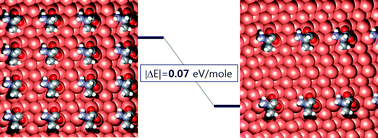Adsorption differences between low coverage enantiomers of alanine on the chiral Cu{421}R surface
Abstract
Chiral separation using heterogeneous methods has long been sought after. Chiral metal surfaces have the potential to make it possible to model these systems using small amino acids, the building blocks for proteins. A comparison of submonolayer concentrations of alanine enantiomers adsorbed onto Cu{421}R has revealed a large geometrical differences between the two molecules as compared to the saturated coverage. Large differences were observed in HR-XPS and NEXAFS and complemented by theoretical DFT calculations. At approximately one third of a monolayer a comparison of the C1s XPS signal showed a shift in the methyl group of more than 300 meV indicating that the two enantiomers are in different chemical environments. NEXAFS spectroscopy confirmed the XPS variations and showed large differences in the orientation of the adsorbed molecules. Our DFT results show that the L-enantiomer is energetically the most stable in the {311} microfacet configuration. In contrast to the full monolayer coverage, these lower coverages showed enhanced selectivity.

- This article is part of the themed collection: 2017 PCCP HOT Articles


 Please wait while we load your content...
Please wait while we load your content...